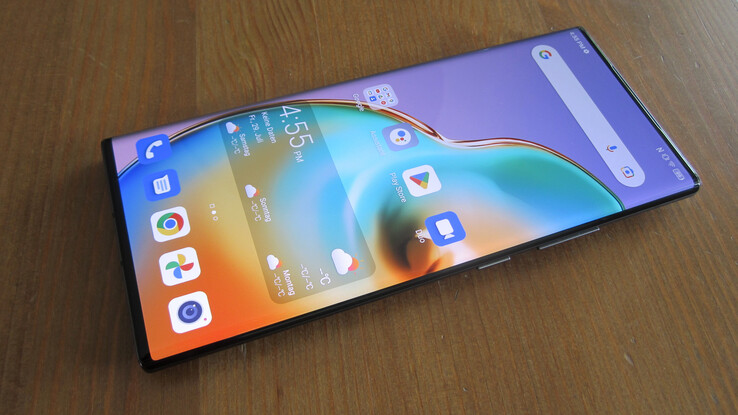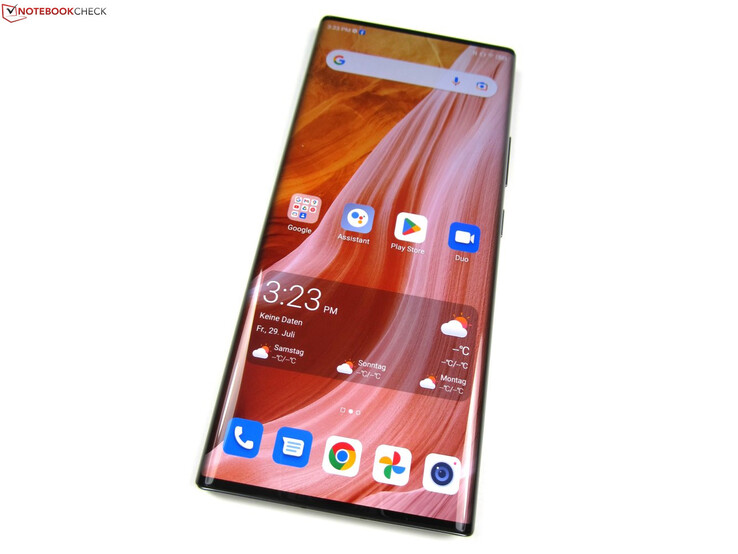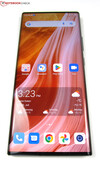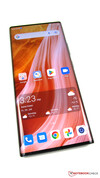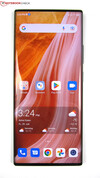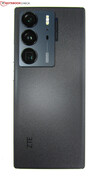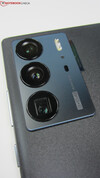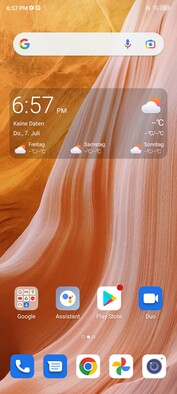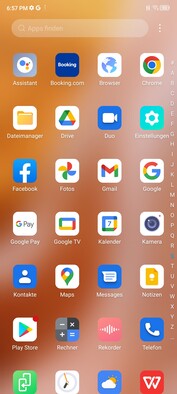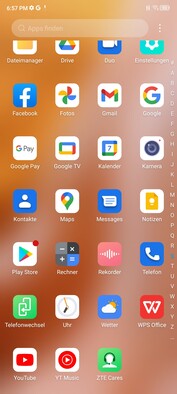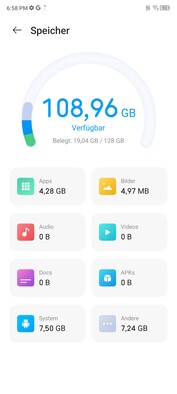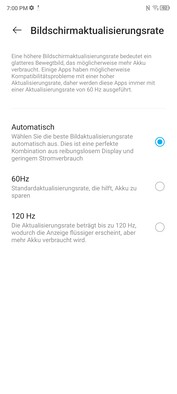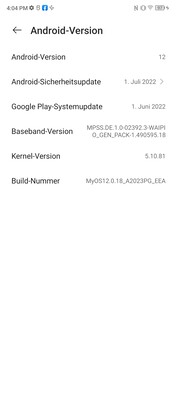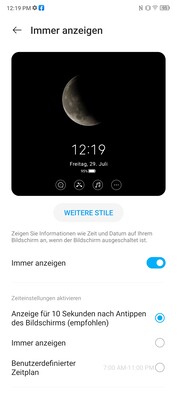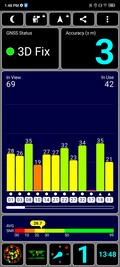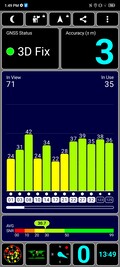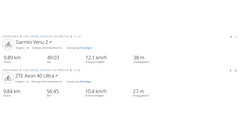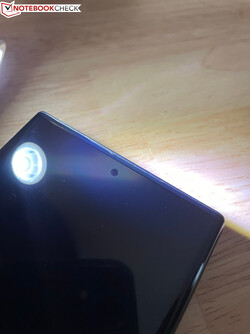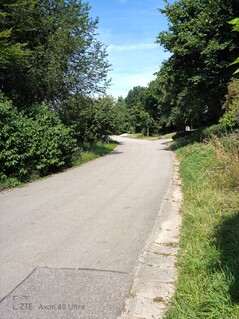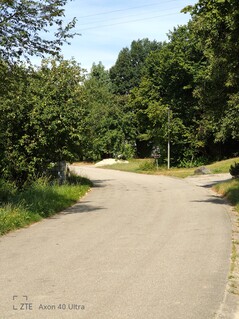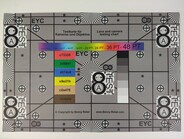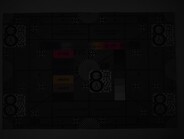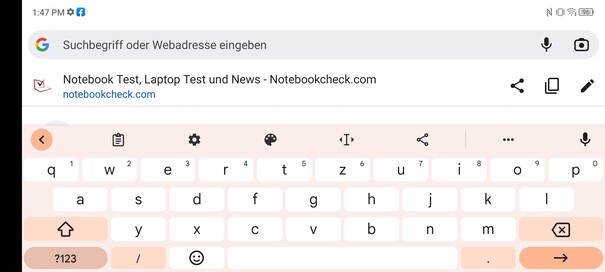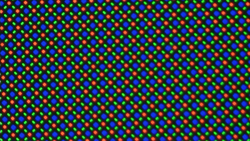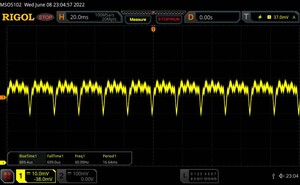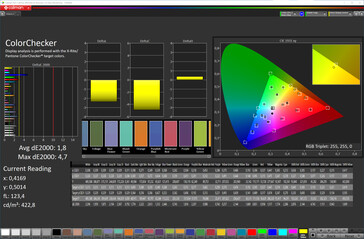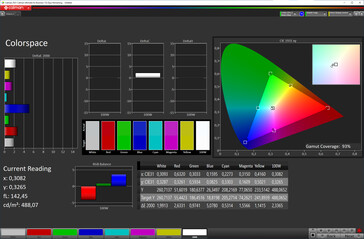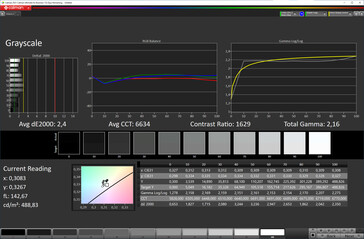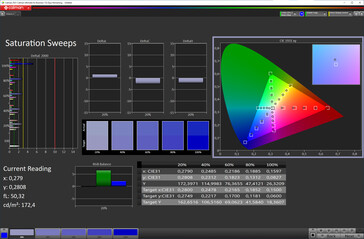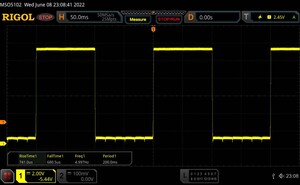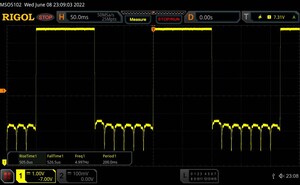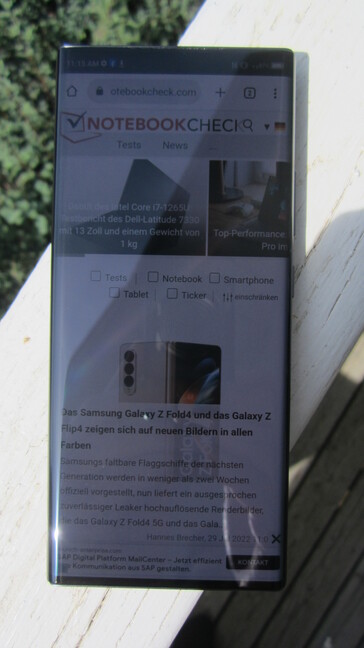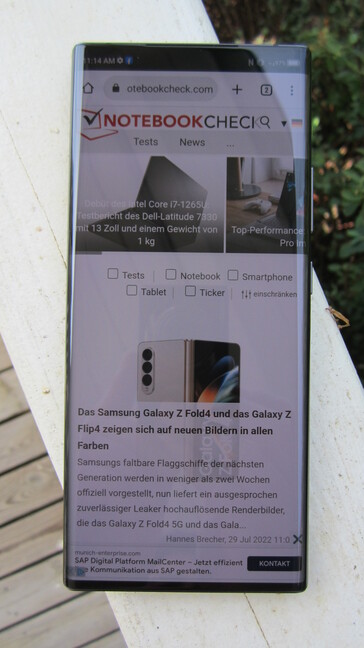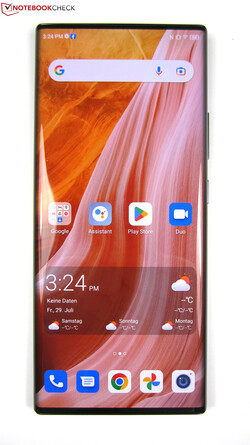Review of ZTE Axon 40 Ultra smartphone - invisible selfie camera, three 64MP cameras and flagship performance
For its new flagship smartphone, the Axon 40 Ultra, ZTE is focusing on the camera systems. This is rather apparent considering that the first 30 pages of the review guide are almost exclusively dedicated to this topic. On the product page, you likewise have to scroll almost all the way to the bottom before you find out more about the smartphone beyond just the features of its cameras.
There are indeed a few things to say about the cameras. On the back cover, you will find the main, ultra-wide and telephoto cameras each featuring a 64MP sensor. On the front, a selfie camera sits beneath the AMOLED display and is thus invisible whilst the phone is in use. Continue to read our review to find out whether this camera package performs just as well as the one on the excellent predecessor, the Axon 30 Ultra.
The rest of the phone's specifications are similarly impressive. At the heart of the phone is a Snapdragon 8 Gen 1 – one of the fastest Android processors available right now. The phone also features up to 12 GB of RAM, 256 GB of storage, a 5,000-mAh battery and an AMOLED display capable of 120 Hz refresh rate and 360 Hz touch sampling rate. A 65-watt charger is included in the box.
Comparison of possible competitors
Rating | Date | Model | Weight | Drive | Size | Resolution | Price |
|---|---|---|---|---|---|---|---|
| 87.5 % v7 (old) | 08 / 2022 | ZTE Axon 40 Ultra SD 8 Gen 1, Adreno 730 | 204 g | 128 GB UFS 3.1 Flash | 6.80" | 2480x1116 | |
| 87.9 % v7 (old) | 03 / 2022 | Motorola Edge 30 Pro SD 8 Gen 1, Adreno 730 | 196 g | 256 GB UFS 3.1 Flash | 6.70" | 2400x1080 | |
| 87.9 % v7 (old) | 04 / 2022 | Oppo Find X5 SD 888 5G, Adreno 660 | 196 g | 256 GB UFS 3.1 Flash | 6.55" | 2400x1080 | |
| 87.4 % v7 (old) | 03 / 2022 | Realme GT 2 Pro SD 8 Gen 1, Adreno 730 | 189 g | 256 GB UFS 3.1 Flash | 6.70" | 3216x1440 | |
| 87.6 % v7 (old) | 02 / 2022 | Xiaomi 12 Pro SD 8 Gen 1, Adreno 730 | 204 g | 256 GB UFS 3.1 Flash | 6.73" | 3200x1440 | |
| 86.4 % v7 (old) | 06 / 2021 | ZTE Axon 30 Ultra 5G SD 888 5G, Adreno 660 | 188 g | 128 GB UFS 3.1 Flash | 6.68" | 2400x1080 |
Chassis - featuring a glass body and curved display
Much like its predecessor, the ZTE Axon 40 Ultra is only available with a matte-black glass body in the EU region. The large camera module on the back cover has become slightly longer due to the vertical arrangement of the sensors, but loses the glossy finish seen on the Axon 30 Ultra. This makes the phone quite unsusceptible to fingerprints as a whole.
Because the AMOLED display curves significantly around the long edges, the front and back of the ZTE Axon 40 Ultra blend together almost seamlessly. However, you can still feel the metal frame a little with your fingers, which doesn't quite fit the otherwise very high-quality feel of the phone. Overall, the device has excellent build quality and feels exceptionally sturdy. Nevertheless, you shouldn't let it drop into water because it is not IP-rated.
The front of the Axon 40 Ultra has a very clean look. There is no need for a hole or notch because the selfie camera is hidden under the display. This allows the screen to occupy a possibly record-breaking 93 per cent of the phone's front. Despite that, the edges of the curved display are still wide enough to ensure that accidental screen presses don't happen often. An optical fingerprint sensor is also located underneath the AMOLED screen.
Specifications - up to 12 GB of RAM and 256 GB of storage
The Axon 40 Ultra is available in two configurations. You can get the version with 8 GB of LPDDR5X RAM and 128 GB of UFS 3.1 storage directly from the manufacturer for 829 Euros (US$799). The higher-end configuration with 12/256 GB costs 949 Euros (US$899). There is no microSD card slot for storage expansion.
The phone has neither a 3.5-mm audio jack nor a radio tuner. It features a pair of stereo speakers, NFC, Bluetooth 5.2 and Miracast for wireless screen mirroring. The OTG-compatible USB-C port supports USB 3.2 Gen 1 and offers transfer rates of up to 5 Gbit/s.
Software - Android 12 and MyOS 12
The Axon 40 Ultra ships with Android 12 and ZTE's own MyOS 12 user interface. At the time of review (early August), the Android security patches on the device were dated 1 June, meaning they were up to date. And because the device supports Widevine DRM L1, it is also able to stream HD content. ZTE hasn't provided any information regarding how long the company intends to continue rolling out updates to the Axon 40 Ultra.
Besides Google apps and a few tools by ZTE, only a few third-party apps are pre-installed on the device, including the Ume browser, Facebook, WPS Office and Booking.com. But all of them can be deleted. After the initial setup, around 109 GB of the 128 GB was usable on our review unit.
Connectivity and GNSS - Wi-Fi 6E and accurate GPS
The dual-SIM ZTE Axon 40 Ultra supports all 4G and 5G frequency bands relevant in the EU region. The Wi-Fi module is compatible with the Wi-Fi 6E standard and was able to achieve high data transfer speeds with our reference router, the Asus ROG Rapture GT-AXE11000.
Data transfer was extremely stable in both the upload and download direction and managed to hit peak speeds of 900 Mbit/s. The initial low transmit rate was due to the router waking up. Even though the phone supports Wi-Fi 6E, we weren't able to use the 6 GHz band.
| Networking | |
| iperf3 receive AXE11000 | |
| Xiaomi 12 Pro | |
| Motorola Edge 30 Pro | |
| ZTE Axon 40 Ultra | |
| Realme GT 2 Pro | |
| Oppo Find X5 | |
| Average of class Smartphone (52 - 1857, n=182, last 2 years) | |
| iperf3 transmit AXE11000 | |
| Xiaomi 12 Pro | |
| Oppo Find X5 | |
| Realme GT 2 Pro | |
| Motorola Edge 30 Pro | |
| ZTE Axon 40 Ultra | |
| Average of class Smartphone (49.8 - 1828, n=182, last 2 years) | |
| iperf3 transmit AX12 | |
| ZTE Axon 30 Ultra 5G | |
| iperf3 receive AX12 | |
| ZTE Axon 30 Ultra 5G | |
The Axon 40 Ultra uses the satellite navigation systems GPS (L1, L5), GLONASS (L1), Galileo (E1, E5a) and BeiDou (B1, B1c, B2a) to identify its location. During our review, the device managed to do so quite swiftly both inside buildings and outdoors – down to an accuracy of 3 metres (~10 feet).
The ZTE phone also delivers accurate position data in daily use. During an approximately 10-km-long (~6.2 mi) bike ride, the Axon 40 Ultra tracked our location almost as accurately as the Garmin Venu 2. Whilst it sometimes deviated slightly from the actual route in more densely built-up sections, the overall accuracy remained high.
Phone functions and call quality - VoLTE and VoWiFi
The dual-sim slot of the Axon 40 Ultra can fit two nano sim cards. The phone supports both VoLTE and VoWiFi. The device delivered good call quality during our testing. The noise reduction worked reliably; during phone calls, everyone on the line could understand the conversation well, even in speakerphone mode.
Cameras - three 64MP cameras and an under-display selfie camera
At first glance, the camera system on the Axon 40 Ultra seems hardly any different from the one on its predecessor, as both of them feature three 64MP sensors. However, the sensors are allocated differently. There are four cameras on the Axon 30 Ultra: a main, an ultra-wide and a portrait camera (each with 64MP) as well as an 8MP telephoto camera.
The Axon 40 Ultra got rid of the portrait camera, opting instead for a triple-camera setup: a main, an ultra-wide and a telephoto camera each equipped with a 64MP sensor.
The phone's main camera (f/1.6, 35 mm, OIS) and the ultra-wide camera (f/2.35, 16 mm) are each fitted with a Sony IMX787 sensor. The ultra-wide camera is also used for macro photography and switches to an autofocus range as close as 4 cm in this mode.
Like the main camera, the 64MP telephoto camera has an optical image stabiliser. It uses a focal length equivalent of 91 mm and a 3.5x optical zoom. If you include the ultra-wide camera, the phone has a total optical zoom range of 5.7x. The phone is able to record videos at up to 8K and 30 fps.
In daylight, the three cameras take excellent photos with image quality that is worthy of a flagship phone. The photos taken during our review look impressive with their natural colours and high dynamic range. Even the edges of the photos retain a high degree of sharpness.
With its equivalent focal length of 35 mm, the main camera is very suitable for portrait photography. The image sharpness is only slightly compromised if you stay within moderate zoom levels of around 5x. The device is capable of 40x digital zoom. The Axon 40 Ultra isn't particularly good at night photography – other flagship smartphones fare much better in this regard.
The most striking camera feature of the Axon 40 Ultra is located on the front. Whilst the Axon 30 Ultra houses its 16MP selfie camera in a punch hole, its successor features an under-display camera that is not visible when the phone in use. Even when the screen is off or dark, you will still have to apply some tricks in order to see the camera. The pixels above the selfie camera turn off when you're using it to take a photo.
During the review, the under-display selfie camera left us feeling conflicted. On the one hand, we like it very much because it makes the screen appear nice and clean. On the other hand, it is nowhere near the same level as standard selfie cameras in terms of image quality, producing nothing but muddy and blurry photos that look worse than those shot using a budget smartphone. However, the issues doesn't lie so much with ZTE. Under-display technology itself is simply not capable of delivering more at the moment.
Image comparison
Choose a scene and navigate within the first image. One click changes the position on touchscreens. One click on the zoomed-in image opens the original in a new window. The first image shows the scaled photograph of the test device.
Daylight shot 1Daylight shot 2Ultra wide-angle5x ZoomLowlight-shotUnder controlled lighting conditions, the main camera demonstrated that it is able to reproduce colours quite accurately and only had a slight slip-up with the darker reference green. Photos of the test chart usually look sharp, but it is almost impossible to make out anything in the picture taken at a low light level of 1 lux.
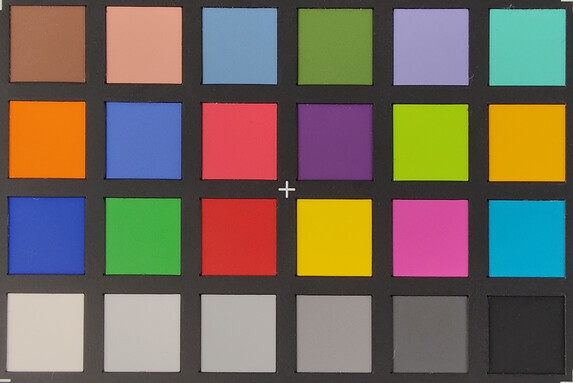
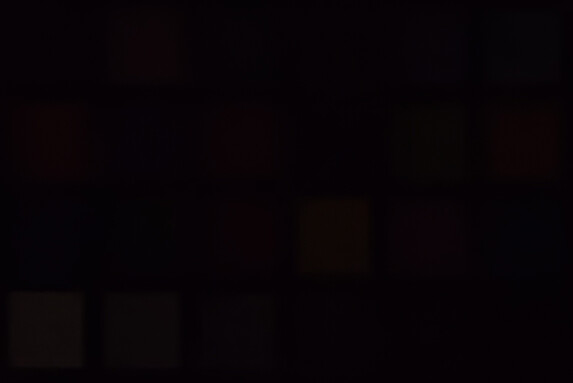
Accessories and warranty - 65-watt charger included
ZTE includes a 65-watt charger, a USB cable, a SIM ejector tool and a transparent protective case with the Axon 40 Ultra. The company doesn't offer any special accessories for the smartphone. But you can purchase protective cases, earphones and other accessories in the ZTE store.
In the EU, the ZTE Axon 40 Ultra comes with a 24-month warranty.
Input devices and usability - 360 Hz touch sampling rate
The device's AMOLED screen responds very accurately to inputs thanks to its high touch sampling rate of 360 Hz. The display's 120 Hz refresh rate ensures that scrolling through menus and websites is a smooth, stutter-free experience.
The optical fingerprint sensor beneath the display unlocks the smartphone quickly and reliably. You can choose from six fingerprint scanner animations with different colours. This, for instance, makes it easier for you improve the visibility of the scanning area based on your lock screen background. Whilst not as secure, the 2D facial recognition is just as responsive as the fingerprint sensor.
Display - AMOLED panel with 120 Hz refresh rate.
The 6.8-inch curved display on the Axon 40 Ultra has a resolution of 2480 x 1116, equivalent to a high pixel density of 400 PPI. The HDR-enabled 20:9 screen runs at 120 Hz and is very evenly lit. The entire panel has an average peak brightness of 683 cd/m².
When the measurement was limited to a smaller area on the panel, it managed to hit a peak brightness of 810 cd/m² (APL18). Without the ambient light sensor, the screen had a brightness of up to 542 cd/m² at the highest setting and just 5 cd/m² at the lowest setting.
The AMOLED panel uses pulse-wide modulation (PWM) to control brightness. At all the brightness levels tested, the PWM operated at a low frequency of 60 Hz. This might pose a problem to users who are sensitive because using a higher brightness setting won't help them avoid PWM flickering. However, we can provide some reassurance: on the Axon 40 Ultra, the PWM waveform is very flat due to the consistently low frequency, meaning the result is similar to permanent DC dimming and should therefore be less straining on the eyes.
| |||||||||||||||||||||||||
Brightness Distribution: 94 %
Center on Battery: 682 cd/m²
Contrast: ∞:1 (Black: 0 cd/m²)
ΔE ColorChecker Calman: 1.8 | ∀{0.5-29.43 Ø4.78}
ΔE Greyscale Calman: 2.4 | ∀{0.09-98 Ø5}
93% sRGB (Calman 2D)
Gamma: 2.16
CCT: 6634 K
| ZTE Axon 40 Ultra AMOLED, 2480x1116, 6.8" | Motorola Edge 30 Pro AMOLED, 2400x1080, 6.7" | Oppo Find X5 AMOLED, 2400x1080, 6.6" | Realme GT 2 Pro AMOLED, 3216x1440, 6.7" | Xiaomi 12 Pro AMOLED, 3200x1440, 6.7" | ZTE Axon 30 Ultra 5G AMOLED, 2400x1080, 6.7" | |
|---|---|---|---|---|---|---|
| Screen | 20% | 22% | -32% | 30% | -89% | |
| Brightness middle (cd/m²) | 682 | 649 -5% | 709 4% | 740 9% | 959 41% | 638 -6% |
| Brightness (cd/m²) | 683 | 649 -5% | 718 5% | 732 7% | 977 43% | 641 -6% |
| Brightness Distribution (%) | 94 | 98 4% | 95 1% | 98 4% | 96 2% | 93 -1% |
| Black Level * (cd/m²) | ||||||
| Colorchecker dE 2000 * | 1.8 | 1.18 34% | 1.3 28% | 3.25 -81% | 1.1 39% | 4 -122% |
| Colorchecker dE 2000 max. * | 4.7 | 2.07 56% | 2.5 47% | 6.46 -37% | 3.1 34% | 14 -198% |
| Greyscale dE 2000 * | 2.4 | 1.5 37% | 1.3 46% | 4.7 -96% | 1.9 21% | 7.2 -200% |
| Gamma | 2.16 102% | 2.236 98% | 2.27 97% | 2.213 99% | 2.22 99% | 2.27 97% |
| CCT | 6634 98% | 2538 256% | 6489 100% | 5663 115% | 6498 100% | 7190 90% |
* ... smaller is better
Screen Flickering / PWM (Pulse-Width Modulation)
| Screen flickering / PWM detected | 60 Hz | ||
The display backlight flickers at 60 Hz (worst case, e.g., utilizing PWM) . The frequency of 60 Hz is very low, so the flickering may cause eyestrain and headaches after extended use. In comparison: 53 % of all tested devices do not use PWM to dim the display. If PWM was detected, an average of 8111 (minimum: 5 - maximum: 343500) Hz was measured. | |||
In the display settings, you can choose from three colour modes: "Colourful", "Standard" and "Soft". Furthermore, colour temperature can be adjusted using either the colour temperature wheel or one of the presets ("Warm", "Normal" and "Cold").
We were able to get the best colour reproduction using a combination of "Soft" colour mode and "Normal" colour temperature. In this case, the colour accuracy falls in the ideal range (Delta E < 3), as is the case with the colour temperature and RGB balance.
Display Response Times
| ↔ Response Time Black to White | ||
|---|---|---|
| 1.42 ms ... rise ↗ and fall ↘ combined | ↗ 0.741 ms rise | |
| ↘ 0.681 ms fall | ||
| The screen shows very fast response rates in our tests and should be very well suited for fast-paced gaming. In comparison, all tested devices range from 0.1 (minimum) to 240 (maximum) ms. » 7 % of all devices are better. This means that the measured response time is better than the average of all tested devices (20.2 ms). | ||
| ↔ Response Time 50% Grey to 80% Grey | ||
| 1.03 ms ... rise ↗ and fall ↘ combined | ↗ 0.505 ms rise | |
| ↘ 0.527 ms fall | ||
| The screen shows very fast response rates in our tests and should be very well suited for fast-paced gaming. In comparison, all tested devices range from 0.165 (minimum) to 636 (maximum) ms. » 3 % of all devices are better. This means that the measured response time is better than the average of all tested devices (31.6 ms). | ||
Performance - powered by Snapdragon 8 Gen 1
The ZTE Axon 40 Ultra is powered by the Snapdragon 8 Gen 1 – currently one of the fastest SoCs for Android phones. The high-end processor, which is able to effortlessly handle even the most challenging of applications, features the Adreno 730 GPU and is paired with either 8 GB or 12 GB of LPDDR5X RAM in the Axon 40 Ultra.
The ZTE is amongst the top performers in synthetic benchmarks and is as fast as other Android phones equipped with the same SoC. Only the AI computations in AIMark didn't work out so well for the Snapdragon 8 Gen 1. The Snapdragon 888 5G, found on phones such as the ZTE Axon 30 Ultra and Oppo Find X5, is not much slower as a whole but performs better in AIMark.
| CrossMark - Overall | |
| Average of class Smartphone (187 - 2674, n=126, last 2 years) | |
| Oppo Find X5 | |
| Average Qualcomm Snapdragon 8 Gen 1 (749 - 1169, n=14) | |
| Xiaomi 12 Pro | |
| ZTE Axon 40 Ultra | |
| AImark - Score v2.x | |
| ZTE Axon 30 Ultra 5G | |
| Oppo Find X5 | |
| Xiaomi 12 Pro | |
| Average Qualcomm Snapdragon 8 Gen 1 (1046 - 96317, n=14) | |
| ZTE Axon 40 Ultra | |
The ZTE Axon 40 Ultra is likewise up there with the best in terms of graphics performance and is one of the fastest Android smartphones available right now.
The four 3DMark benchmarks (Sling Shot Extreme ES 3.1, Sling Shot Extreme Vulkan Unlimited, Sling Shot OpenGL ES 3.0 Unlimited and Wild Life) were no match for the powerful SoC – the phone wasn't even given a score (maxed out).
| 3DMark | |
| Wild Life Extreme Unlimited | |
| Realme GT 2 Pro | |
| Xiaomi 12 Pro | |
| ZTE Axon 40 Ultra | |
| Motorola Edge 30 Pro | |
| Oppo Find X5 | |
| ZTE Axon 30 Ultra 5G | |
| Wild Life Extreme | |
| Xiaomi 12 Pro | |
| Realme GT 2 Pro | |
| ZTE Axon 40 Ultra | |
| Motorola Edge 30 Pro | |
| ZTE Axon 30 Ultra 5G | |
| Oppo Find X5 | |
| Wild Life Unlimited Score | |
| Xiaomi 12 Pro | |
| Realme GT 2 Pro | |
| ZTE Axon 40 Ultra | |
| Motorola Edge 30 Pro | |
| Oppo Find X5 | |
| ZTE Axon 30 Ultra 5G | |
| 2560x1440 Sling Shot Extreme (ES 3.1) Unlimited Physics | |
| Xiaomi 12 Pro | |
| ZTE Axon 40 Ultra | |
| Oppo Find X5 | |
| 2560x1440 Sling Shot Extreme (ES 3.1) Unlimited Graphics | |
| ZTE Axon 40 Ultra | |
| Xiaomi 12 Pro | |
| Oppo Find X5 | |
| 2560x1440 Sling Shot Extreme (ES 3.1) Unlimited | |
| Xiaomi 12 Pro | |
| ZTE Axon 40 Ultra | |
| Oppo Find X5 | |
| 2560x1440 Sling Shot OpenGL ES 3.0 Unlimited | |
| Oppo Find X5 | |
| ZTE Axon 40 Ultra | |
| Xiaomi 12 Pro | |
| 2560x1440 Sling Shot OpenGL ES 3.0 Unlimited Graphics | |
| Xiaomi 12 Pro | |
| ZTE Axon 40 Ultra | |
| Oppo Find X5 | |
| 2560x1440 Sling Shot OpenGL ES 3.0 Unlimited Physics | |
| Oppo Find X5 | |
| ZTE Axon 40 Ultra | |
| Xiaomi 12 Pro | |
| GFXBench (DX / GLBenchmark) 2.7 | |
| T-Rex Onscreen | |
| Xiaomi 12 Pro | |
| ZTE Axon 30 Ultra 5G | |
| Motorola Edge 30 Pro | |
| ZTE Axon 40 Ultra | |
| Realme GT 2 Pro | |
| Oppo Find X5 | |
| 1920x1080 T-Rex Offscreen | |
| ZTE Axon 40 Ultra | |
| Xiaomi 12 Pro | |
| Realme GT 2 Pro | |
| Motorola Edge 30 Pro | |
| Oppo Find X5 | |
| ZTE Axon 30 Ultra 5G | |
| GFXBench 3.0 | |
| on screen Manhattan Onscreen OGL | |
| ZTE Axon 40 Ultra | |
| Motorola Edge 30 Pro | |
| ZTE Axon 30 Ultra 5G | |
| Xiaomi 12 Pro | |
| Oppo Find X5 | |
| Realme GT 2 Pro | |
| 1920x1080 1080p Manhattan Offscreen | |
| Xiaomi 12 Pro | |
| Realme GT 2 Pro | |
| ZTE Axon 40 Ultra | |
| Oppo Find X5 | |
| ZTE Axon 30 Ultra 5G | |
| Motorola Edge 30 Pro | |
| GFXBench 3.1 | |
| on screen Manhattan ES 3.1 Onscreen | |
| ZTE Axon 40 Ultra | |
| Motorola Edge 30 Pro | |
| ZTE Axon 30 Ultra 5G | |
| Xiaomi 12 Pro | |
| Oppo Find X5 | |
| Realme GT 2 Pro | |
| 1920x1080 Manhattan ES 3.1 Offscreen | |
| Xiaomi 12 Pro | |
| Realme GT 2 Pro | |
| Oppo Find X5 | |
| Motorola Edge 30 Pro | |
| ZTE Axon 40 Ultra | |
| ZTE Axon 30 Ultra 5G | |
| GFXBench | |
| on screen Car Chase Onscreen | |
| Motorola Edge 30 Pro | |
| ZTE Axon 40 Ultra | |
| Oppo Find X5 | |
| ZTE Axon 30 Ultra 5G | |
| Realme GT 2 Pro | |
| Xiaomi 12 Pro | |
| 1920x1080 Car Chase Offscreen | |
| Realme GT 2 Pro | |
| Motorola Edge 30 Pro | |
| Oppo Find X5 | |
| Xiaomi 12 Pro | |
| ZTE Axon 40 Ultra | |
| ZTE Axon 30 Ultra 5G | |
| on screen Aztec Ruins High Tier Onscreen | |
| Motorola Edge 30 Pro | |
| ZTE Axon 40 Ultra | |
| Oppo Find X5 | |
| ZTE Axon 30 Ultra 5G | |
| Realme GT 2 Pro | |
| Xiaomi 12 Pro | |
| 2560x1440 Aztec Ruins High Tier Offscreen | |
| Motorola Edge 30 Pro | |
| Realme GT 2 Pro | |
| Xiaomi 12 Pro | |
| ZTE Axon 40 Ultra | |
| ZTE Axon 30 Ultra 5G | |
| Oppo Find X5 | |
| on screen Aztec Ruins Normal Tier Onscreen | |
| Motorola Edge 30 Pro | |
| ZTE Axon 40 Ultra | |
| ZTE Axon 30 Ultra 5G | |
| Oppo Find X5 | |
| Realme GT 2 Pro | |
| Xiaomi 12 Pro | |
| 1920x1080 Aztec Ruins Normal Tier Offscreen | |
| Motorola Edge 30 Pro | |
| Realme GT 2 Pro | |
| Xiaomi 12 Pro | |
| ZTE Axon 40 Ultra | |
| Oppo Find X5 | |
| ZTE Axon 30 Ultra 5G | |
The ZTE phone is also lightning fast when browsing the Internet. Websites and images load very quickly and can be scrolled through rapidly.
| Jetstream 2 - 2.0 Total Score | |
| Average of class Smartphone (23.8 - 387, n=154, last 2 years) | |
| ZTE Axon 40 Ultra (Chrome 103.0.5060.71) | |
| Oppo Find X5 (Chrome 99.0.4844.73) | |
| Motorola Edge 30 Pro (Chrome 99) | |
| Average Qualcomm Snapdragon 8 Gen 1 (72.8 - 134.6, n=16) | |
| ZTE Axon 30 Ultra 5G (chrome 90) | |
| Realme GT 2 Pro (Chrome 99) | |
| Xiaomi 12 Pro (Chrome 97) | |
| Speedometer 2.0 - Result 2.0 | |
| Average of class Smartphone (15.2 - 643, n=128, last 2 years) | |
| Motorola Edge 30 Pro (Chome 99) | |
| Realme GT 2 Pro (Chome 99) | |
| Oppo Find X5 (Chrome 99.0.4844.73) | |
| ZTE Axon 40 Ultra (Chrome 103.0.5060.71) | |
| ZTE Axon 30 Ultra 5G (chrome 90) | |
| Average Qualcomm Snapdragon 8 Gen 1 (64.4 - 129.3, n=16) | |
| Xiaomi 12 Pro (Chrome 97) | |
| WebXPRT 3 - Overall | |
| Oppo Find X5 (Chrome 99.0.4844.73) | |
| Average of class Smartphone (38 - 380, n=35, last 2 years) | |
| Motorola Edge 30 Pro (Chrome 99) | |
| ZTE Axon 30 Ultra 5G (chrome 90) | |
| Average Qualcomm Snapdragon 8 Gen 1 (79 - 193, n=15) | |
| Xiaomi 12 Pro (Chrome 97) | |
| ZTE Axon 40 Ultra (Chrome 103.0.5060.71) | |
| Octane V2 - Total Score | |
| Motorola Edge 30 Pro (Chrome 99) | |
| Average of class Smartphone (2228 - 121337, n=201, last 2 years) | |
| ZTE Axon 40 Ultra (Chrome 103.0.5060.71) | |
| Oppo Find X5 (Chrome 99.0.4844.73) | |
| Average Qualcomm Snapdragon 8 Gen 1 (27730 - 50626, n=17) | |
| ZTE Axon 30 Ultra 5G (chrome 90) | |
| Realme GT 2 Pro (Chrome 99) | |
| Xiaomi 12 Pro (Chrome 97) | |
| Mozilla Kraken 1.1 - Total | |
| Xiaomi 12 Pro (Chrome 97) | |
| ZTE Axon 30 Ultra 5G (chrome 90) | |
| Average of class Smartphone (257 - 28190, n=156, last 2 years) | |
| Realme GT 2 Pro (Chrome 99) | |
| Average Qualcomm Snapdragon 8 Gen 1 (814 - 1440, n=16) | |
| Oppo Find X5 (Chrome 99.0.4844.73) | |
| Motorola Edge 30 Pro (Chrome 99) | |
| ZTE Axon 40 Ultra (Chrome 103.0.5060.71) | |
* ... smaller is better
The Axon 40 Ultra uses fast UFS 3.1 storage, similar to other devices in the comparison. The device demonstrated that it is even faster than the Axon 30 Ultra when it comes to storage speed.
| ZTE Axon 40 Ultra | Motorola Edge 30 Pro | Oppo Find X5 | Realme GT 2 Pro | Xiaomi 12 Pro | ZTE Axon 30 Ultra 5G | Average 128 GB UFS 3.1 Flash | Average of class Smartphone | |
|---|---|---|---|---|---|---|---|---|
| AndroBench 3-5 | 6% | -6% | 2% | 26% | -21% | -16% | 32% | |
| Sequential Read 256KB (MB/s) | 1638.15 | 1832 12% | 1964 20% | 1749 7% | 1620 -1% | 1464 -11% | 1586 ? -3% | 2223 ? 36% |
| Sequential Write 256KB (MB/s) | 1065.13 | 1028 -3% | 782 -27% | 1225 15% | 1465 38% | 689 -35% | 763 ? -28% | 1838 ? 73% |
| Random Read 4KB (MB/s) | 313.35 | 277.7 -11% | 272.9 -13% | 273 -13% | 324.9 4% | 208.2 -34% | 243 ? -22% | 295 ? -6% |
| Random Write 4KB (MB/s) | 273.19 | 339.5 24% | 259.3 -5% | 264 -3% | 448.9 64% | 265 -3% | 241 ? -12% | 335 ? 23% |
Games - smooth gameplay even at the highest settings
The Adreno 730 doesn't have any problems running current games even at the highest settings. However, PUBG Mobile caps the frame rate at 30 fps when running at HD/high settings, probably to help save battery. Armajet also has a similar frame rate cap, albeit at 60 fps.
Frame rates during gameplay were measured using GameBench.
Emissions - the Axon 40 Ultra stays cool even under load
Temperature
Although the Snapdragon 8 Gen 1 is brimming with computing power, it can only fully tap into this performance for a relatively brief period of time. When the SoC gets too warm – something that happens quite quickly – it will start decreasing its clock speed and operating at reduced performance. However, the lowered clock speed is still so high that you won't notice any throttling. Moreover, the phone's chassis hardly gets warm during use. With temperatures reaching a maximum of 34.9 °C (94.8 °F), the exterior of the phone remained cool even under load and was always comfortable to touch. In comparison, its predecessor runs significantly hotter.
(+) The maximum temperature on the upper side is 34.8 °C / 95 F, compared to the average of 35.2 °C / 95 F, ranging from 21.9 to 247 °C for the class Smartphone.
(+) The bottom heats up to a maximum of 34.9 °C / 95 F, compared to the average of 34 °C / 93 F
(+) In idle usage, the average temperature for the upper side is 29.3 °C / 85 F, compared to the device average of 32.9 °C / 91 F.
3DMark Wild Life Stress Test
| 3DMark | |
| Wild Life Stress Test Stability | |
| ZTE Axon 30 Ultra 5G | |
| Realme GT 2 Pro | |
| ZTE Axon 40 Ultra | |
| Motorola Edge 30 Pro | |
| Oppo Find X5 | |
| Wild Life Extreme Stress Test | |
| ZTE Axon 30 Ultra 5G | |
| ZTE Axon 40 Ultra | |
| Oppo Find X5 | |
| Realme GT 2 Pro | |
| Motorola Edge 30 Pro | |
Speakers
The two DTS:X Ultra-enabled speakers on the Axon 40 Ultra can be quite loud at 85.5 dB(A) and sounds like what you might expect from a typical smartphone: mids and highs are balanced, but bass is in short supply.
External audio devices can be connected to the phone via a USB-C audio adapter or wirelessly over Bluetooth 5.2. The following Bluetooth codecs are supported: aptX, aptX HD, aptX Adaptive, AAC, LDAC and SBC.
ZTE Axon 40 Ultra audio analysis
(+) | speakers can play relatively loud (85.5 dB)
Bass 100 - 315 Hz
(-) | nearly no bass - on average 31.4% lower than median
(±) | linearity of bass is average (10.8% delta to prev. frequency)
Mids 400 - 2000 Hz
(+) | balanced mids - only 2.3% away from median
(+) | mids are linear (5.1% delta to prev. frequency)
Highs 2 - 16 kHz
(±) | higher highs - on average 5.2% higher than median
(+) | highs are linear (2.7% delta to prev. frequency)
Overall 100 - 16.000 Hz
(±) | linearity of overall sound is average (19.5% difference to median)
Compared to same class
» 28% of all tested devices in this class were better, 8% similar, 64% worse
» The best had a delta of 11%, average was 35%, worst was 134%
Compared to all devices tested
» 48% of all tested devices were better, 7% similar, 45% worse
» The best had a delta of 4%, average was 24%, worst was 134%
ZTE Axon 30 Ultra 5G audio analysis
(+) | speakers can play relatively loud (89.3 dB)
Bass 100 - 315 Hz
(-) | nearly no bass - on average 29.5% lower than median
(±) | linearity of bass is average (10.1% delta to prev. frequency)
Mids 400 - 2000 Hz
(+) | balanced mids - only 4.5% away from median
(+) | mids are linear (4.2% delta to prev. frequency)
Highs 2 - 16 kHz
(±) | higher highs - on average 5.2% higher than median
(+) | highs are linear (3% delta to prev. frequency)
Overall 100 - 16.000 Hz
(±) | linearity of overall sound is average (19.2% difference to median)
Compared to same class
» 25% of all tested devices in this class were better, 9% similar, 66% worse
» The best had a delta of 11%, average was 35%, worst was 134%
Compared to all devices tested
» 45% of all tested devices were better, 7% similar, 47% worse
» The best had a delta of 4%, average was 24%, worst was 134%
Battery life - the Axon 40 Ultra is long-lasting
Power consumption
The Axon 40 Ultra consumes less power and is remarkably more efficient than most of the device in our comparison, particular whilst running at maximum load.
A 65-watt power adapter (20 V/3.35 A) is included for charging the 5000-mAh battery. During our test, it took just 46 minutes to charge the phone from 0 to 100 per cent; the phone was already 80 per cent full after just 30 minutes.
The Axon 40 Ultra doesn't support wireless charging.
| Off / Standby | |
| Idle | |
| Load |
|
Key:
min: | |
| ZTE Axon 40 Ultra 5000 mAh | Motorola Edge 30 Pro 4800 mAh | Oppo Find X5 4800 mAh | Realme GT 2 Pro 5000 mAh | Xiaomi 12 Pro 4600 mAh | ZTE Axon 30 Ultra 5G 4600 mAh | Average Qualcomm Snapdragon 8 Gen 1 | Average of class Smartphone | |
|---|---|---|---|---|---|---|---|---|
| Power Consumption | -26% | -0% | -11% | 3% | -20% | -26% | -14% | |
| Idle Minimum * (Watt) | 0.88 | 1.2 -36% | 1.01 -15% | 1 -14% | 0.94 -7% | 1 -14% | 1.255 ? -43% | 0.848 ? 4% |
| Idle Average * (Watt) | 1.57 | 1.6 -2% | 1.59 -1% | 1.4 11% | 1.24 21% | 1.99 -27% | 2.02 ? -29% | 1.434 ? 9% |
| Idle Maximum * (Watt) | 1.6 | 2.5 -56% | 1.6 -0% | 1.7 -6% | 1.34 16% | 2.02 -26% | 2.21 ? -38% | 1.618 ? -1% |
| Load Average * (Watt) | 5.06 | 5.2 -3% | 3.87 24% | 5.3 -5% | 5.7 -13% | 5.15 -2% | 5.49 ? -8% | 7.01 ? -39% |
| Load Maximum * (Watt) | 7.91 | 10.4 -31% | 8.74 -10% | 11.1 -40% | 8.12 -3% | 10.36 -31% | 8.75 ? -11% | 11.3 ? -43% |
* ... smaller is better
Power consumption: Geekbench (150 cd/m²)
Power consumption: GFXBench (150 cd/m²)
Battery life
The Axon 40 Ultra has excellent battery life. In our Wi-Fi test comparable to real-life use, the 5,000-mAh battery only gave up after more than 16 hours. The smartphone is also capable of playing an H.264 video for an entire day. Although the Axon 40 Ultra's competitors aren't able to fully keep up with it, they have similarly good battery life in general.
| ZTE Axon 40 Ultra 5000 mAh | Motorola Edge 30 Pro 4800 mAh | Oppo Find X5 4800 mAh | Realme GT 2 Pro 5000 mAh | Xiaomi 12 Pro 4600 mAh | ZTE Axon 30 Ultra 5G 4600 mAh | |
|---|---|---|---|---|---|---|
| Battery runtime | -16% | -13% | -9% | -18% | -37% | |
| Reader / Idle (h) | 40.8 | 33.1 -19% | 34.6 -15% | 34.3 -16% | 33.9 -17% | |
| H.264 (h) | 24.5 | 16.8 -31% | 21.6 -12% | 18.1 -26% | 13.1 -47% | |
| WiFi v1.3 (h) | 16.3 | 13.6 -17% | 15.6 -4% | 17.6 8% | 12.8 -21% | 10.3 -37% |
| Load (h) | 4.9 | 5.1 4% | 3.9 -20% | 4.9 0% | 5.6 14% |
Pros
Cons
Verdict: Axon 40 Ultra
The Axon 40 Ultra is ZTE's current flagship phone and represents a compelling overall package at its official price of 829 Euros (US$799). Its strong points include the AMOLED panel that is capable of 120 Hz refresh rate and 360 Hz touch sampling rate. This makes the smartphone extremely responsive. Adding to that are features such as the high-end Snapdragon 8 Gen 1 SoC, up to 12 GB of LPDDR5X RAM and 256 GB of UFS 3.1 storage. The ZTE phone also impresses with its very good battery life and the 65-watt adapter that can fully charge the device in about 45 minutes.
The ZTE Axon 40 Ultra looks good, is lightning fast, has very long battery life and stands out with an innovative camera setup. However, the under-display selfie camera produces lacklustre image quality.
The cameras are the most remarkable feature on this extremely well-built ZTE smartphone. The three 64MP cameras take very good photos and easily outclass most higher-end smartphones in terms of image quality. The camera setup is, nevertheless, not quite good enough for a place in the absolute high-end segment due to its poor low-light performance.
The selfie camera is also a mixed bag of the good and the bad. Because the selfie camera is under the display, there is neither a punch hole nor a notch on the screen for the camera, thus giving the Axon 40 Ultra a very "clean" look. However, the selfie camera thoroughly disappoints in terms of image quality. That said, the Axon 40 Ultra may still be attractive for some people due to its invisible selfie camera. This is because not every smartphone user needs a front camera, conducts video chats with it or places a lot of importance on its image quality.
We would have liked to see a few more features on a "real" flagship phone, such as IP rating and wireless charging. Looking at its competitors like Apple, Samsung and Google, we also need to mention the company's update policy. It is currently still unclear how long ZTE intends to provide the Axon 40 Ultra with Android upgrades and security updates.
Great alternatives to the ZTE Axon 40 Ultra include the Motorola Edge 30 Pro and Xiaomi 12 Pro. Those who enjoy taking photos with their phone should take a closer look at the Google Pixel 6 Pro.
Price and availability
ZTE Axon 40 Ultra
- 08/30/2022 v7 (old)
Manuel Masiero




